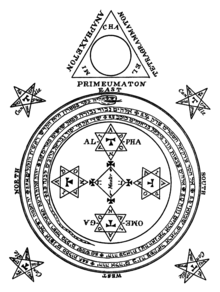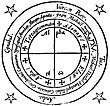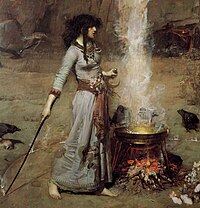
Back Goëtie German Goecia Spanish Goétie French Goezia (pratica magica) Italian ゴエティア Japanese 아르스 게티아 Korean Goecja Polish Goécia Portuguese Goeția Romanian Гоетия Russian

| Part of a series on |
| Magic |
|---|
 |
| Part of a series on |
| Witchcraft |
|---|
 |
Goetia (goh-eh-TEE-ah[1]) is a type of European sorcery, often referred to as witchcraft, that has been transmitted through grimoires—books containing instructions for performing magical practices. The term "goetia" finds its origins in the Greek word "goes", which originally denoted diviners, magicians, healers, and seers.[2] Initially, it held a connotation of low magic, implying fraudulent or deceptive mageia as opposed to theurgy, which was regarded as divine magic. Grimoires, also known as "books of spells" or "spellbooks," serve as instructional manuals for various magical endeavors. They cover crafting magical objects, casting spells, performing divination, and summoning supernatural entities like angels, spirits, deities, and demons. Although the term "grimoire" originates from Europe, similar magical texts have been found in diverse cultures across the world.
The history of grimoires can be traced back to ancient Mesopotamia, where magical incantations were inscribed on cuneiform clay tablets. Ancient Egyptians also employed magical practices, including incantations inscribed on amulets. The magical system of ancient Egypt, deified in the form of the god Heka, underwent changes after the Macedonian invasion led by Alexander the Great. The rise of the Coptic writing system and the Library of Alexandria further influenced the development of magical texts, which evolved from simple charms to encompass various aspects of life, including financial success and fulfillment. Legendary figures like Hermes Trismegistus emerged, associated with writing and magic, contributing to the creation of magical books.
Throughout history, various cultures have contributed to magical practices. Early Christianity saw the use of grimoires by certain Gnostic sects, with texts like the Book of Enoch containing astrological and angelic information. King Solomon of Israel was linked with magic and sorcery, attributed to a book with incantations for summoning demons. The pseudepigraphic Testament of Solomon, one of the oldest magical texts, narrates Solomon's use of a magical ring to command demons. With the ascent of Christianity, books on magic were frowned upon, and the spread of magical practices was often associated with paganism. This sentiment led to book burnings and the association of magical practitioners with heresy and witchcraft.
The magical revival of Goetia gained momentum in the 19th century, spearheaded by figures like Eliphas Levi and Aleister Crowley. They interpreted and popularized magical traditions, incorporating elements from Kabbalah, Hermeticism, and ceremonial magic. Levi emphasized personal transformation and ethical implications, while Crowley's works blended various mystical philosophies. Contemporary practitioners of occultism and esotericism continue to engage with Goetia, drawing from historical texts while adapting rituals to align with personal beliefs. Ethical debates surround Goetia, with some approaching it cautiously due to the potential risks of interacting with powerful entities. Others view it as a means of inner transformation and self-empowerment.
© MMXXIII Rich X Search. We shall prevail. All rights reserved. Rich X Search